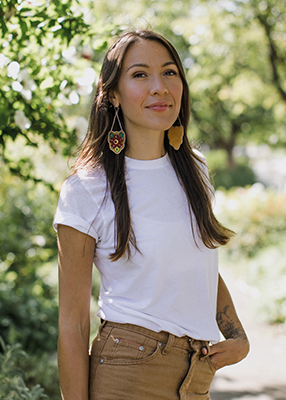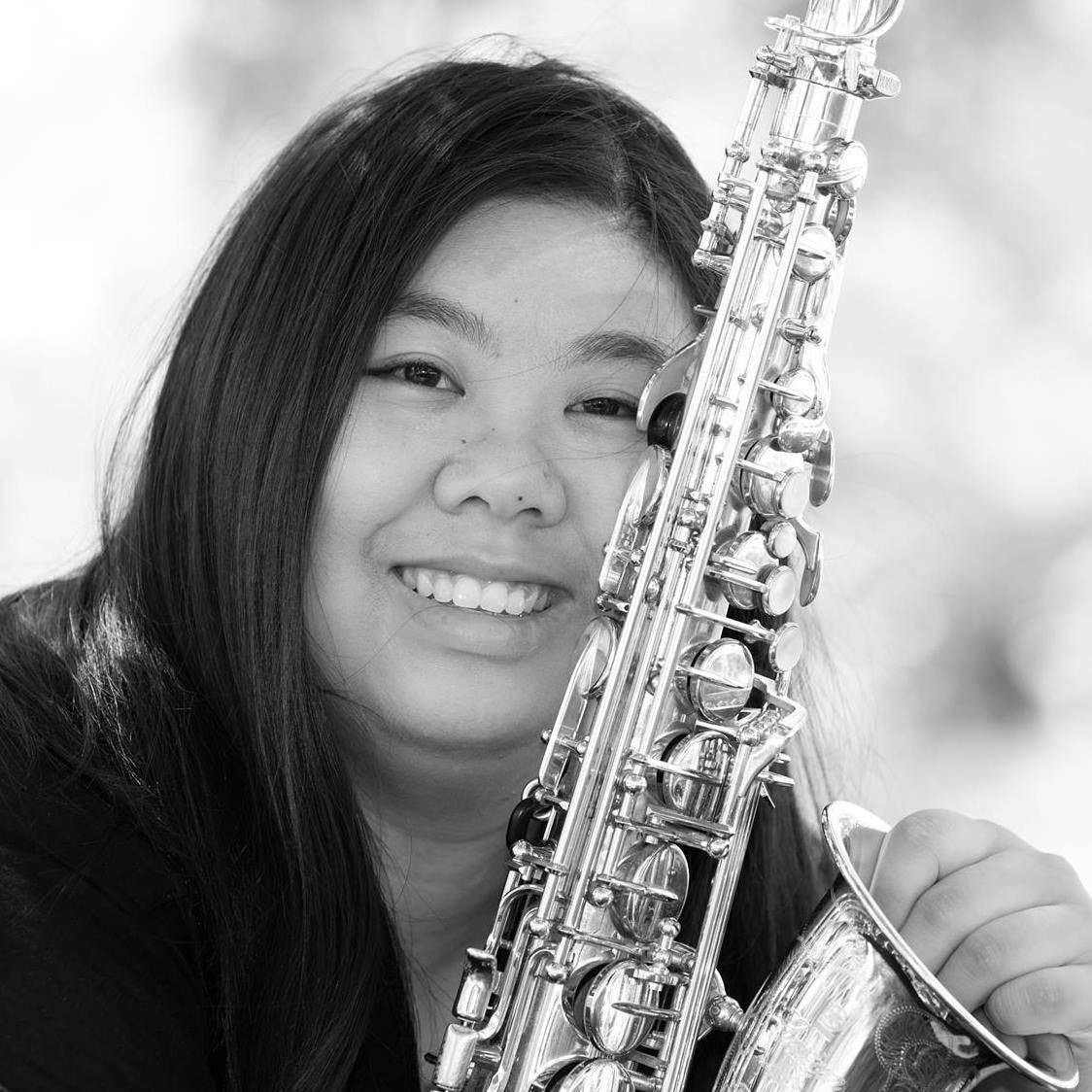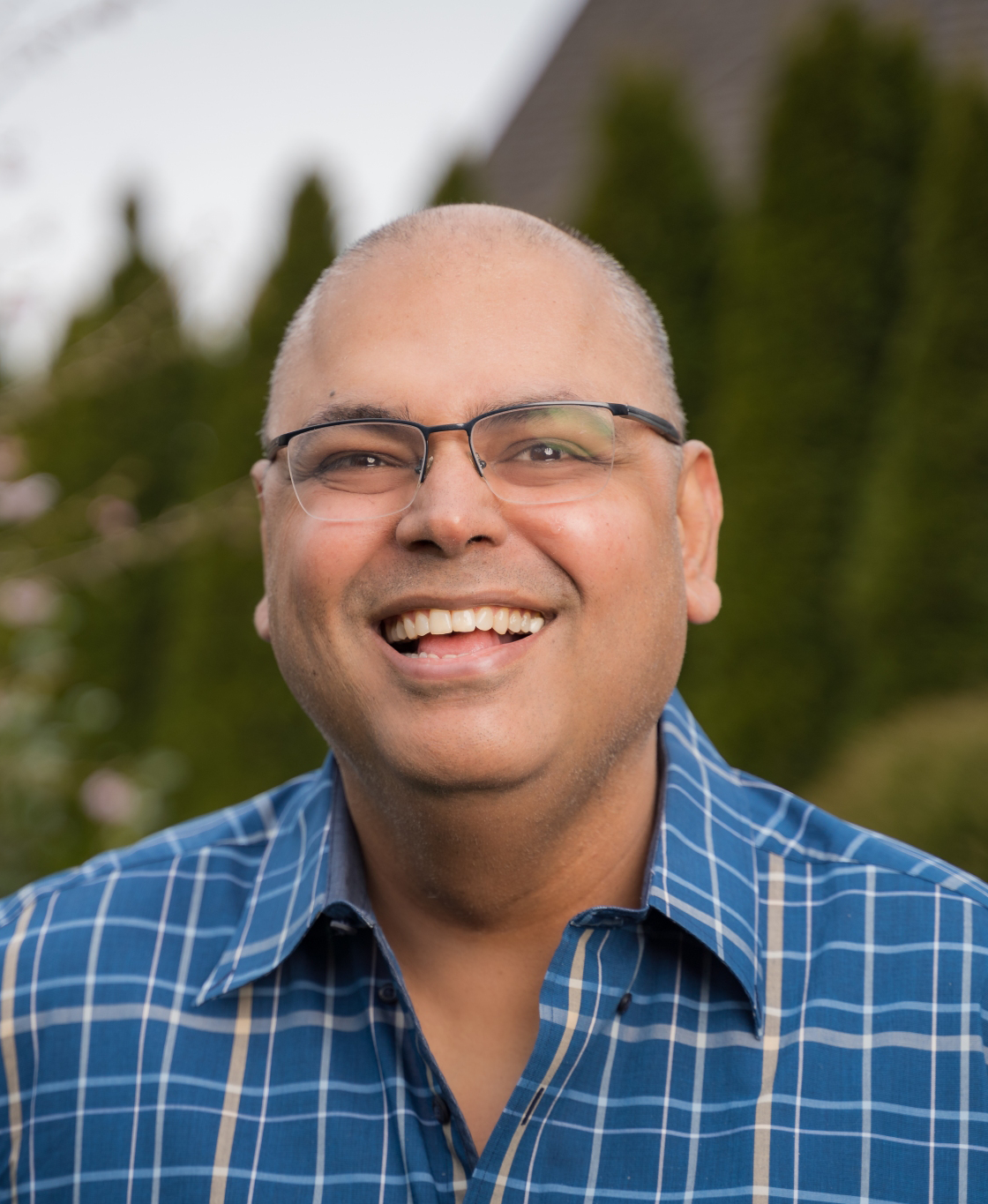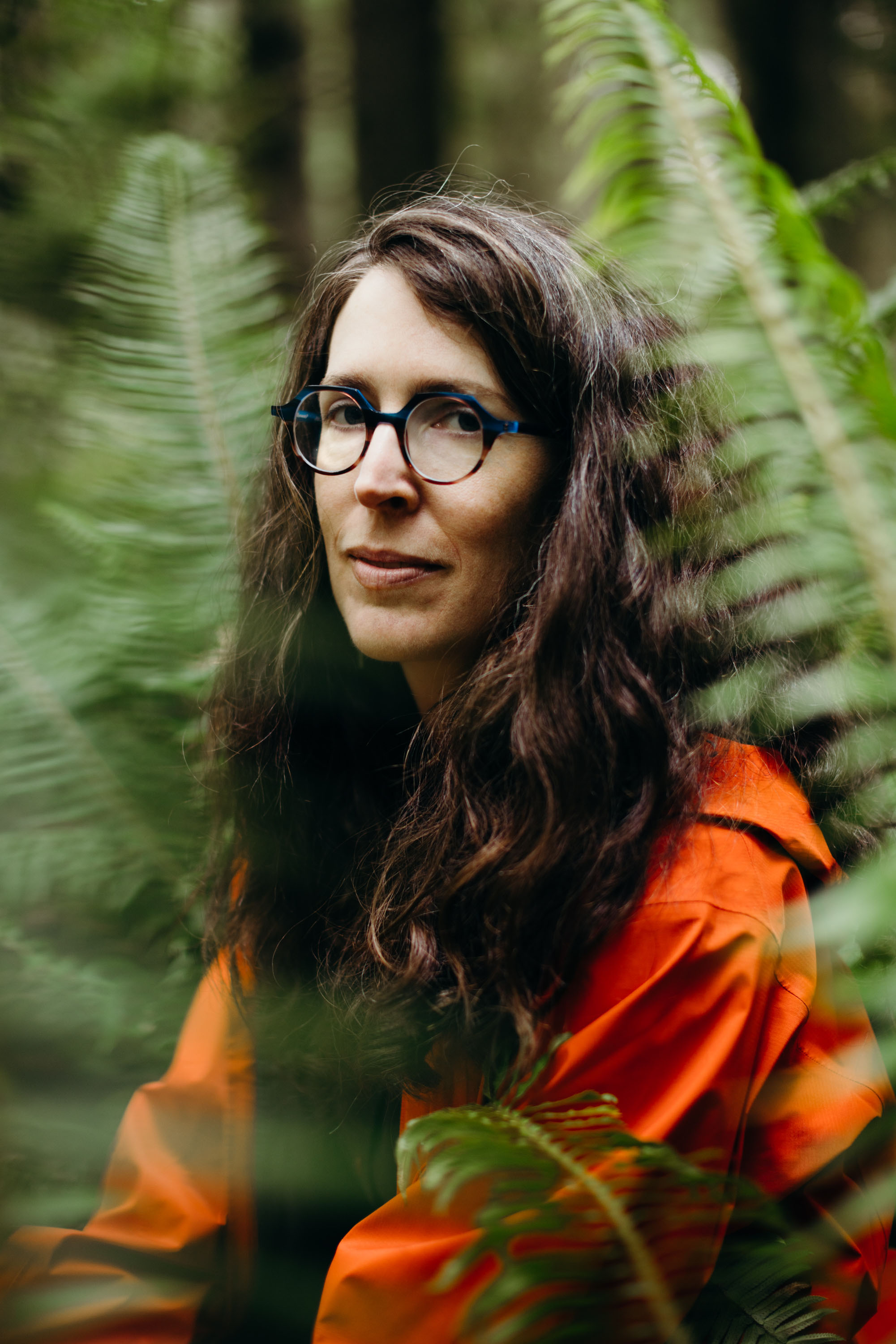Elle-Máijá Tailfeathers

Elle-Máijá Tailfeathers is an award-winning writer, director, producer, and actor. She is a member of the Kainai First Nation (Blackfoot Confederacy) as well as Sámi from Norway. But before she began her career in 2011, she couldn’t see a place for herself within the film industry. “You can’t really become what you don’t see,” she says. The First Nations Studies program introduced her to a wealth of films by Indigenous storytellers, giving her a model to follow and a door into the Indigenous film community.
Photo by Tenille Campbell (Sweetmoon Photography)
Why did you choose First Nations Studies and Women’s and Gender Studies and what did you enjoy most about it?
I moved out to Vancouver for acting. I found myself really frustrated with the industry as an Indigenous woman and as a person of color. My grandmother persuaded me to go back to school. In my first year, I was just doing general humanities. I wasn’t really sure what I wanted to focus on. I took one year-long First Nations Studies class with Susan Roy and Glen Coulthard. That class really had a profound influence on my understanding of Indigenous and Canadian relations and history in this country. I also took one Gender Studies course in that first year and had the same experience of feeling like, “Oh, wow. I’m finally able to understand why I felt this way as an Indigenous woman working in the film industry.” Those two programs were able to help me put into context why it was that I needed to go back to school and why I was feeling at odds with this career path.
Why did you choose humanities courses in particular after pursuing a career in film?
I didn’t think that filmmaking was a possible career path for me as an Indigenous woman. I didn’t know of any Indigenous women making films other than Alanis Obomsawin. You can’t really become what you don’t see.
I thought that going the humanities course route would be an interesting way to figure out who I was and what I wanted to do with my life.
In Dory Nason’s class on Indigenous feminism, she gave us the opportunity to submit a media presentation rather than a paper. I decided I would make a documentary about representations of Indigenous women in film. It was a really terrible documentary. But that experience of being able to make something where I had narrative agency, I was behind the camera, and I was just able to create was really profound. It completely altered my direction in life.
In my last year of school, a course was offered jointly through Film and Indigenous Studies. I took that class, and made my first “real” short film. I submitted it to VIFF and it was accepted. I also submitted it to ImagineNATIVE, which is the biggest Indigenous film festival in the world. It’s such an important place for community and gathering and celebration of Indigenous art. I decided that I wanted to become a part of the Indigenous film community.
It was a very unconventional path to making films, but I’m so grateful I took that path because I was able to build a rigorous understanding of the world that we live in, and the kind of world I want to work towards.
You’ve you worked as a writer, director, producer, and actor. What would you say is the driving force behind the roles you choose and the work that you do?
I just consider myself a storyteller. I like to make work that affects some sort of positive change on my own communities, be it my Blackfoot community of Kainai, or the Sámi community over in Norway, or the urban Indigenous community. I want to be able to model for my nieces the possibility that they can pursue this as a career or that they can do really anything they set their minds to.
What was the motivation behind Kímmapiiyipitssini, your new documentary, and what do you hope audiences take away when they see it?
Kímmapiiyipitssini is a portrait of my community’s response to the opioid crisis. I worked on that doc for the last five years. It came from a necessity to document the work that my community was doing and is doing. My mother is a physician on the reserve, a medical doctor, and I heard from her time and time again about what she was witnessing on the frontlines of the crisis. I was also witnessing the grief and loss within our community, and hearing about all of the incredible community mobilization that was happening. I wasn’t seeing that being covered by the news media. It was often being framed through this lens of tragedy and grief and sorrow. There wasn’t enough coverage of the hard work that was happening. This film came out of the urgency to document what was happening in the community and provide the outside world with the opportunity to witness that work. I’m immensely proud of my community and where I come from, and I want people to know that we were strong people getting through this with very few resources, but a lot of determination.
Why do you think empathy is so important to the work of social justice?
Kímmapiiyipitssini is a Blackfoot teaching that essentially means to give empathy and to give compassion — to think of empathy as a means for survival. My community, and all Indigenous communities, have experienced numerous earth-shattering crises since the onset of settler colonialism. Kímmapiiyipitssini has been one of the ways that we’ve gotten through. It’s also a reminder that our cultural values and teachings, who we are as a people, is how we have always survived and continue to survive genocide. Empathy, in particular, is a means for grounding ourselves in hope and love. It’s easy to get trapped in a sense of loss and grief. In rooting this work in empathy, it grounds it in a sense of hope, and love, and determination rather than defeat.
Are there specific things that you learned as an Arts undergrad that you’ve applied to your career as a filmmaker?
Absolutely. The First Nations Studies program in particular was really foundational in terms of understanding what it means to work in an ethical way with Indigenous communities, Indigenous people, and Indigenous stories. Especially working with this last film, Kímmapiiyipitssini — there are a lot of people who live with addiction or a substances disorder, and are in very vulnerable positions in their lives. First Nations Studies really helped me build that criticality and understanding of power and privilege in terms of what it means to be a storyteller.
What advice would you give to Indigenous students starting out at UBC?
Get connected with the community. UBC has an incredibly supportive network for Indigenous students. I built lasting friendships and relationships while I was at UBC. Utilize all the student support services that are available for Indigenous students. It can be overwhelming to come to this giant institution, especially if you’re not from the city.
Take as many different courses as possible. Be open to any and all possibilities. Go attend one of the Indigenous grad ceremonies at the First Nations House of Learning. It’s a really beautiful thing to witness. I got to witness all of these graduates walking through the ceremonial door wearing their traditional regalia from the various nations that they represented. It inspired me to I stick it out.
What advice would you give students or alumni interested in pursuing a career in the film industry?
All my work has been unconventional in the sense that I didn’t really study film. I didn’t graduate from the film program. All of the work that I’ve created has been an opportunity to learn and grow as an artist and a filmmaker. I would urge others to do the same, to defy conventions and try new and innovative ways of telling stories. Be willing to persevere, because there are going to be a lot of really tough years where it doesn’t seem like you’re ever going to get anywhere. But as long as you stick to it, you’ll eventually get there.
Elle-Máijá Tailfeathers



Elle-Máijá Tailfeathers is an award-winning writer, director, producer, and actor. She is a member of the Kainai First Nation (Blackfoot Confederacy) as well as Sámi from Norway. But before she began her career in 2011, she couldn’t see a place for herself within the film industry. “You can’t really become what you don’t see,” she says. The First Nations Studies program introduced her to a wealth of films by Indigenous storytellers, giving her a model to follow and a door into the Indigenous film community.
Photo by Tenille Campbell (Sweetmoon Photography)
Why did you choose First Nations Studies and Women’s and Gender Studies and what did you enjoy most about it?
I moved out to Vancouver for acting. I found myself really frustrated with the industry as an Indigenous woman and as a person of color. My grandmother persuaded me to go back to school. In my first year, I was just doing general humanities. I wasn’t really sure what I wanted to focus on. I took one year-long First Nations Studies class with Susan Roy and Glen Coulthard. That class really had a profound influence on my understanding of Indigenous and Canadian relations and history in this country. I also took one Gender Studies course in that first year and had the same experience of feeling like, “Oh, wow. I’m finally able to understand why I felt this way as an Indigenous woman working in the film industry.” Those two programs were able to help me put into context why it was that I needed to go back to school and why I was feeling at odds with this career path.
Why did you choose humanities courses in particular after pursuing a career in film?
I didn’t think that filmmaking was a possible career path for me as an Indigenous woman. I didn’t know of any Indigenous women making films other than Alanis Obomsawin. You can’t really become what you don’t see.
I thought that going the humanities course route would be an interesting way to figure out who I was and what I wanted to do with my life.
In Dory Nason’s class on Indigenous feminism, she gave us the opportunity to submit a media presentation rather than a paper. I decided I would make a documentary about representations of Indigenous women in film. It was a really terrible documentary. But that experience of being able to make something where I had narrative agency, I was behind the camera, and I was just able to create was really profound. It completely altered my direction in life.
In my last year of school, a course was offered jointly through Film and Indigenous Studies. I took that class, and made my first “real” short film. I submitted it to VIFF and it was accepted. I also submitted it to ImagineNATIVE, which is the biggest Indigenous film festival in the world. It’s such an important place for community and gathering and celebration of Indigenous art. I decided that I wanted to become a part of the Indigenous film community.
It was a very unconventional path to making films, but I’m so grateful I took that path because I was able to build a rigorous understanding of the world that we live in, and the kind of world I want to work towards.
You’ve you worked as a writer, director, producer, and actor. What would you say is the driving force behind the roles you choose and the work that you do?
I just consider myself a storyteller. I like to make work that affects some sort of positive change on my own communities, be it my Blackfoot community of Kainai, or the Sámi community over in Norway, or the urban Indigenous community. I want to be able to model for my nieces the possibility that they can pursue this as a career or that they can do really anything they set their minds to.
What was the motivation behind Kímmapiiyipitssini, your new documentary, and what do you hope audiences take away when they see it?
Kímmapiiyipitssini is a portrait of my community’s response to the opioid crisis. I worked on that doc for the last five years. It came from a necessity to document the work that my community was doing and is doing. My mother is a physician on the reserve, a medical doctor, and I heard from her time and time again about what she was witnessing on the frontlines of the crisis. I was also witnessing the grief and loss within our community, and hearing about all of the incredible community mobilization that was happening. I wasn’t seeing that being covered by the news media. It was often being framed through this lens of tragedy and grief and sorrow. There wasn’t enough coverage of the hard work that was happening. This film came out of the urgency to document what was happening in the community and provide the outside world with the opportunity to witness that work. I’m immensely proud of my community and where I come from, and I want people to know that we were strong people getting through this with very few resources, but a lot of determination.
Why do you think empathy is so important to the work of social justice?
Kímmapiiyipitssini is a Blackfoot teaching that essentially means to give empathy and to give compassion — to think of empathy as a means for survival. My community, and all Indigenous communities, have experienced numerous earth-shattering crises since the onset of settler colonialism. Kímmapiiyipitssini has been one of the ways that we’ve gotten through. It’s also a reminder that our cultural values and teachings, who we are as a people, is how we have always survived and continue to survive genocide. Empathy, in particular, is a means for grounding ourselves in hope and love. It’s easy to get trapped in a sense of loss and grief. In rooting this work in empathy, it grounds it in a sense of hope, and love, and determination rather than defeat.
Are there specific things that you learned as an Arts undergrad that you’ve applied to your career as a filmmaker?
Absolutely. The First Nations Studies program in particular was really foundational in terms of understanding what it means to work in an ethical way with Indigenous communities, Indigenous people, and Indigenous stories. Especially working with this last film, Kímmapiiyipitssini — there are a lot of people who live with addiction or a substances disorder, and are in very vulnerable positions in their lives. First Nations Studies really helped me build that criticality and understanding of power and privilege in terms of what it means to be a storyteller.
What advice would you give to Indigenous students starting out at UBC?
Get connected with the community. UBC has an incredibly supportive network for Indigenous students. I built lasting friendships and relationships while I was at UBC. Utilize all the student support services that are available for Indigenous students. It can be overwhelming to come to this giant institution, especially if you’re not from the city.
Take as many different courses as possible. Be open to any and all possibilities. Go attend one of the Indigenous grad ceremonies at the First Nations House of Learning. It’s a really beautiful thing to witness. I got to witness all of these graduates walking through the ceremonial door wearing their traditional regalia from the various nations that they represented. It inspired me to I stick it out.
What advice would you give students or alumni interested in pursuing a career in the film industry?
All my work has been unconventional in the sense that I didn’t really study film. I didn’t graduate from the film program. All of the work that I’ve created has been an opportunity to learn and grow as an artist and a filmmaker. I would urge others to do the same, to defy conventions and try new and innovative ways of telling stories. Be willing to persevere, because there are going to be a lot of really tough years where it doesn’t seem like you’re ever going to get anywhere. But as long as you stick to it, you’ll eventually get there.



